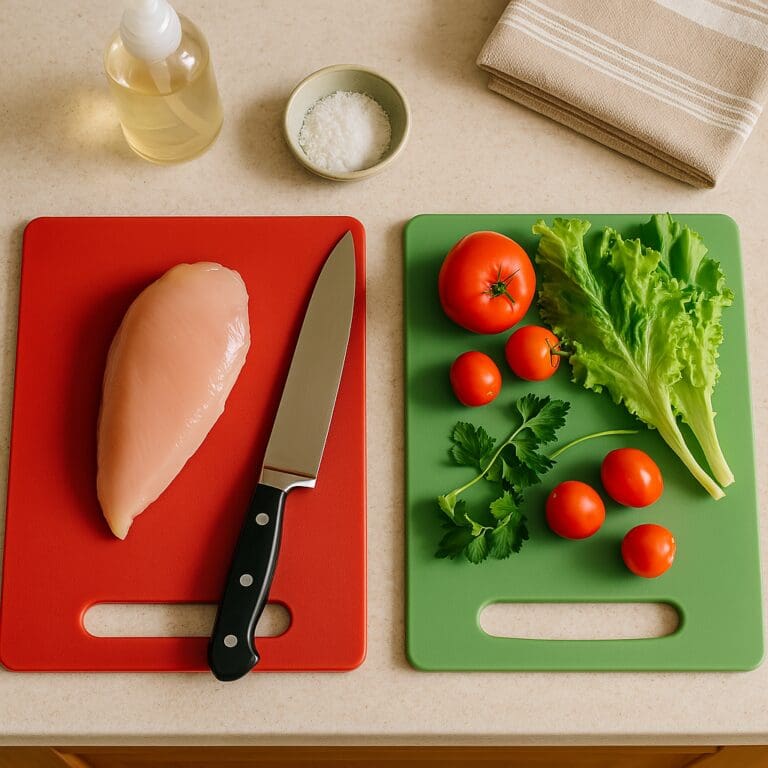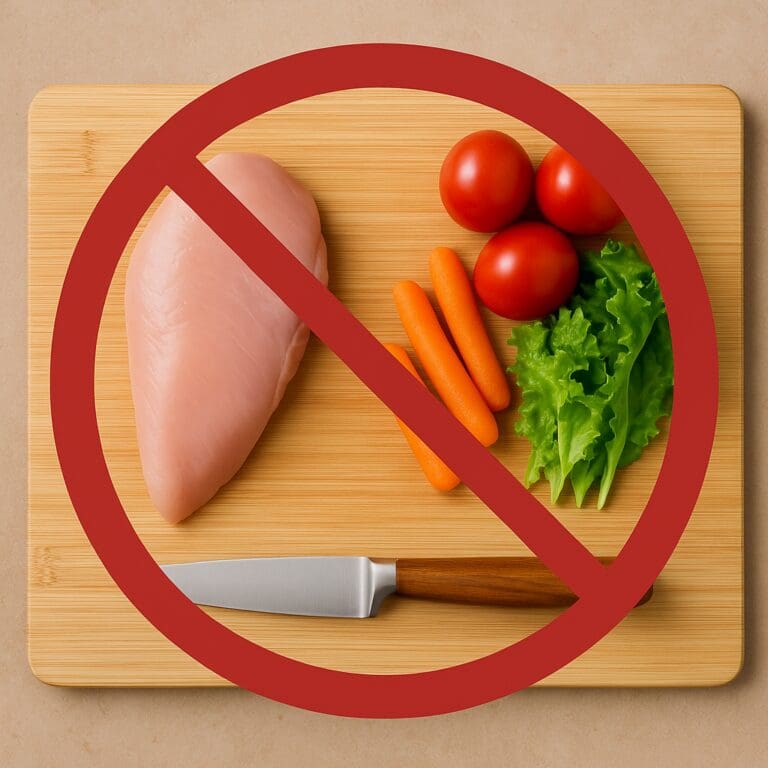Introduction
Cross-contamination can happen in an instant—and most of the time, you won’t even see it. A quick phone check mid-recipe, a knife used for both raw chicken and salad greens, or a damp dish towel used one too many times. It’s one of the leading causes of foodborne illness in home kitchens, but the good news? It’s also highly preventable.
Cross-contamination in home cooking isn’t just a meat issue. It involves tools, surfaces, produce, hands, and even tech devices. This post will walk you through what cross-contamination really is, what causes it, and how to build safer habits at home—even if you’re working with just one cutting board and a single sponge.
What Is Cross-Contamination?
At its core, cross-contamination is the transfer of harmful bacteria, viruses, or allergens from one surface or food to another—often without realizing it. It’s a common cause of foodborne illness and can happen at any stage of cooking.
The 4 Main Types of Cross-Contamination
Understanding how contamination spreads is the first step toward breaking the cycle:
1. Food-to-Food
- Raw meat juices drip onto fresh greens in the fridge.
- You use the same bowl to marinate and serve.
2. Surface-to-Food
- You chop raw chicken, wipe the board quickly, and start slicing fruit
3. Hand-to-Food
- You touch your phone mid-prep, then dice veggies without washing your hands.
4. Tool-to-Food
- You flip raw meat with tongs, then use the same tongs to plate the cooked version.
Common Kitchen Contaminants (and Where They Lurk)
Here’s a quick look at the most common foodborne threats and where they tend to show up:
Contaminant | Common Source | Spread in the Home Kitchen |
|---|---|---|
E. coli | Ground beef, raw produce
| Leaks from meat packages, unwashed greens
|
Salmonella | Raw poultry, eggs, produce | Dirty hands, shared knives or boards |
Listeria | Deli meats, soft cheeses | Cross-contaminated fridge shelves, unclean storage |
Norovirus | Unwashed hands, surfaces | Spread from hand-to-food or unclean utensils
|
Want a deeper dive? We’ll cover more about common food contaminants in the home kitchen in an upcoming post.
Best Practices for Preventing Cross-Contamination
These kitchen safety tips help prevent foodborne illness without overcomplicating your routine:
- Wash hands before and after handling any raw ingredients
- Clean and sanitize surfaces and tools between tasks
- Keep raw meat separate from other groceries and meal components
- Store raw meats **sealed and on the bottom shelf ** in a tray or pan to catch any drips and prevent them from contaminating other items
- Use different utensils or wash thoroughly between raw and cooked foods

Quick Guide: Cleaning vs. Sanitizing
This is one of the most common points of confusion—and one of the most important.
- Cleaning means removing dirt, crumbs, and grease using soap and water. In most home kitchens, this usually involves dish soap, all-purpose kitchen sprays, or vinegar-based solutions. Choose a food-safe cleaner that’s labeled for kitchen use, especially for surfaces where food is prepared. Double-check the label to see whether the cleaner should be rinsed off before food contact—some products require a water rinse after application to be considered food-safe.
- Sanitizing means reducing germs and bacteria to safe levels, often with heat or chemicals.
Think of it this way:
Cleaning gets rid of what you can see. Sanitizing handles what you can’t.
How to Sanitize at Home
You don’t need industrial chemicals to sanitize properly. Here are safe, effective sanitizing methods that use what you likely already have:
- Bleach Solution: Mix 1 tablespoon of unscented bleach with 1 gallon of water. Use on clean surfaces and let air dry. This solution can also be used to sanitize dishes and utensils—just soak the clean items for at least one minute and let them air dry. Be sure to check product labels or manufacturer instructions to confirm that your tools are bleach-safe. For detailed instructions, refer to Clorox’s official dish sanitizing guide.
- Dishwasher with High-Heat Cycle: Great for sponges, cutting boards, and utensils labeled “dishwasher safe.”
Microwave (for sponges): Wet the sponge and microwave it for 1 minute to reduce some bacteria. However, according to the USDA, this method alone is not sufficient to eliminate all contaminants, and sponges should be replaced frequently. USDA – Kitchen Sponge Cleaning • Martha Stewart – How to Clean a Sponge
One Cutting Board or Kitchen Utensil? No Problem!
No problem. You don’t need fancy gear—you just need a smart routine.
If you only have one board or one set of knives:
- Wash with hot, soapy water after prepping each food type
- Sanitize using one of the methods above
- Let it air dry completely before using again
The same goes for tools like tongs, spatulas, or peelers. Clean and sanitize them between uses to stop bacteria in their tracks.
The Biggest Offenders (and What to Do About Them)
Some items make it easier for bacteria to spread—but with a few tweaks, you can keep things under control.
- Cutting Boards: Ideally, use separate ones for meat, produce, and bread. If you only have one, clean and sanitize between tasks.
- Sponges & Towels:
- Sponges: Sanitize by microwaving a wet sponge for one minute or placing it in the dishwasher on a hot cycle. Replace if it smells or falls apart. Note that according to the USDA, microwaving sponges may reduce bacteria but doesn’t fully eliminate the risk of contamination—sponges should still be replaced regularly. USDA – Kitchen Sponge Cleaning Guide • Martha Stewart – How to Clean a Sponge
- Towels: Use a clean one daily or rotate a few. If reusing, let it dry fully and boil or hot-wash every few days to kill bacteria.
- Sponges: Sanitize by microwaving a wet sponge for one minute or placing it in the dishwasher on a hot cycle. Replace if it smells or falls apart. Note that according to the USDA, microwaving sponges may reduce bacteria but doesn’t fully eliminate the risk of contamination—sponges should still be replaced regularly. USDA – Kitchen Sponge Cleaning Guide • Martha Stewart – How to Clean a Sponge
- Reusable Grocery Bags: Bacteria from raw meats can linger. Wash bags regularly—especially after meat or dairy trips. Food Republic – Wash Your Reusable Grocery Bags
- Phones & Devices: Use a stylus or voice commands when cooking. If you touch your device mid-prep, wash your hands before returning to the food.
- Countertops and Stovetops: These high-touch surfaces are often overlooked. Wipe them down with a food-safe cleaner and sanitize regularly—especially after prepping raw meat or cleaning up spills.
Phones & Devices: Use voice commands when cooking. If you touch your device mid-prep, wash your hands before returning to the food.
Cooking Isn’t Cleaning: Why Heat Alone Isn’t Enough
It’s tempting to think, “It’ll cook out.” But while high heat kills bacteria, it doesn’t erase the risk of cross-contamination in home cooking during prep. That cutting board you didn’t sanitize? Still a threat.
Safe cooking means:
- Clean tools before they touch ready-to-eat foods
- Don’t reuse containers or plates that held raw items
- Take a minute to sanitize before plating your finished dish
Quick Reference: Do’s and Don’ts for Cross-Contamination
✅ Do | ❌ Don’t |
|---|---|
Wash hands before switching tasks
| Use the same board for all foods without cleaning
|
Sanitize counters and tools
| Skip cleaning between raw and cooked steps |
Let cooked food rest on clean plates | Return food to raw-meat containers
|
Use dry, clean towels
| Reuse damp cloths all week
|
You’ve Got This—And Your Kitchen Does, Too
Kitchen safety is a practice, not a performance. You don’t need to be perfect—you just need to be aware. A little mindfulness goes a long way toward keeping your meals safe and your household healthy.
👉 Do a quick kitchen check:
- Are your tools clean and sanitized?
- When was your towel last washed?
- Are raw items stored where they can drip?
These small tweaks build long-term kitchen confidence. You deserve a cooking space that feels both joyful and safe.
Looking for More?
Explore all of our Taysty Tips to build confidence and skill in your everyday kitchen routines.
🍽️ Want to keep improving your kitchen habits?
Check out our Kitchen Safety Series for more Taysty Tips that help you cook with confidence, not stress.
